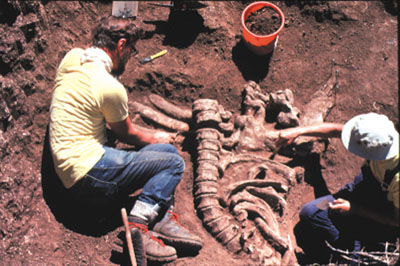julyheader.html

News
Notes
Field
Notes
Aussie extinction
During the Pleistocene, a menagerie of gigantic animals traversed the
forests and plains of Australia. These oddities included Diprotodon,
a lumbering hippo-sized marsupial, Genyornis, a 6-foot-tall flightless
bird, and Procoptodon goliah, the largest kangaroo ever, weighing
in at more than 440 pounds at 6.5 to 10 feet in height. These animals,
referred to as megafauna (more than 100 pounds), suffered a rapid and drastic
extinction event about 46,400 years ago, a team of researchers reports
in the June 8 Science. The team sampled megafaunal fossils and surrounding
sediments from 27 cave, creek and lake localities spanning the continent.
They timed this Pleistocene extinction using 230Th/234U and optical dating
— a technique measuring the luminescence of minerals since burial — instead
of 14C dating, which the authors note becomes problematic for specimens
older than 35,000 years.

[At right: The skeleton of a 53,000 year-old
Diprotodon optatum — the largest species of megafauna — being excavated
by Alex Ritchie, left, of the Australian Museum, from Cox’s Creek in northern
New South Wales, Australia. Photo from Howard Hughes, Australian Museum]
Scientists had thought that Australian megafauna went extinct due to
the cold and arid conditions of the last glacial maximum about 19,000 to
23,000 years ago. The new extinction age data reveal, however, that the
animals declined before the Ice Age and after humans arrived to Australia
about 50,000 years ago. Humans could have decimated megafaunal populations
through hunting or, more likely, burning their habitats. Such destruction
of vast areas of vegetation would drive out large game. Robbed of food
and territory, the animals would go extinct. Though the mass extinction
wiped out virtually all megafauna, the genus containing kangaroos survived.
Jann Vendetti
A quarantine conundrum
The next sampling mission to Mars won’t bring martian samples to Earth
until 2015, but scientists say it’s not too early to start building a quarantine
facility, according to a National Research Council (NRC) report released
May 29.
Because 2015 will be the first time martian samples are brought to Earth,
NASA should build a quarantine facility to protect Earth from possible
contamination by the samples — and to protect the samples from contamination
by Earth, the NRC report says. This double role means such a facility will
take at least seven years to build, the report concludes, so work should
start soon.
The probability that martian samples will contain hazardous organisms
is low, but it cannot be ignored, NRC says. The facility should quarantine
the samples until scientists are sure they don’t contain living organisms.
Any containment facility would require both biological containment,
to protect Earth’s environment, and clean-room conditions, to protect the
samples from terrestrial microbes or dust. Biological containment chambers
store samples at lower-than-ambient air pressures to ensure that potential
leakage draws air into the chamber. But clean-room chambers enclose samples
at greater-than-ambient air pressures, so that leakage is outward and external
contaminants cannot move toward the samples.
Neeta Bijoor, contributing writer
Smithsonian museum director resigns
After five years as director of the Smithsonian’s National Museum of
Natural History, Robert W. Fri announced his resignation May 29. During
his tenure, the number of museum visitors almost doubled, an IMAX theater
was built and existing exhibits were revamped. Fri’s decision to leave
follows the announcement by Lawrence M. Small, Secretary of the Smithsonian
Institution, that the museum’s finances and academic pursuits will be redirected.
Some research programs will be eliminated and others reorganized in efforts
to keep the museum’s competitive edge in everything from marine biology
to paleobotany.
Small has headed the Smithsonian since January 2000. His background
in finance and business rather than science has prompted criticism that
he aims to increase the museum’s public appeal at the cost of scientific
integrity. Earlier this year, Small stirred up controversy for proposing
to eliminate the Conservation Research Center in Virginia, which breeds
and studies endangered species of the National Zoo. Within the Natural
History Museum, his proposed restructuring of research would channel museum
scientists’ responsibilities away from the museum to the Smithsonian Science
Undersecretary. When he announced his resignation, Fri said, “This separation
would leave the museum to concentrate on exhibit and education functions.
I do not feel that I can make that commitment enthusiastically.”
Fri added that his position with the museum was “an extraordinary and
rewarding time.”
Jann Vendetti


